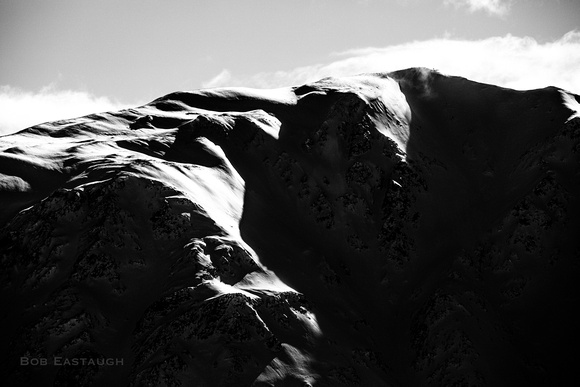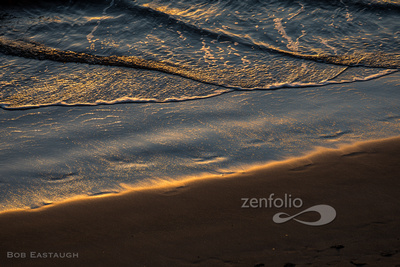High Contrast; March 2017
High contrast images reduce tonal range. Processing an image file this way (or using a high contrast product like Kodalith in the darkroom) effectively discards mid-tone data. Whether that data is useful to a given viewer might be a debatable. For example, a climber interested in scouting a new route to the summit wouldn't want to rely on these image files. But for others, high contrast reduces the image to its most basic elements of shape, and can permit a dramatic and dynamic rendering of something that is normally depicted more prosaically.
Of course most people would not consider any image of Turnagain Arm and Cook Inlet along the Seward Highway on a sunny winter day to be completely prosaic. But here is what happens when very high contrast is applied digitally.


Here I just wanted to capture the back-lit chevrons on the lower ridge line. They provided a strong graphic, brightly illuminated and standing out visually from the shadowed peak and ridge. By Turnagain Arm standards, the scene in nature really was relatively prosaic; the mountain was not dramatic compared to nearby features, nor was the natural mid-day light very striking. But the chevrons were striking, and I pulled into a highway parking lot expressly to catch them with a long lens. Applying high contrast in the computer now allows me to display the essence of what I saw at the time.


This scene, also of mountains across the inlet from the Seward Highway, offered the same sort of juxtaposition of light and dark, but here lighted snow fields smoothly flowed from the ridge and then dropped precipitously into the shadowed face.


Today across the inlet from Girdwood this dramatic stretch of ridge rose to a peak partially obscured by gauzy clouds carried by the wind around and over the peak. High contrast here retains the illuminated water and floating ice debris in the inlet, contrasting with the dark shore and front face of the mountain.


Again, this high valley, a verdant meadow three months of the year, is bright with snow illuminated by direct sun. The juxtaposition emphasizes the valley's graceful sweep.




Two different views of a peak and ridgeline. One is black and white high contrast, and the other retains blue, without a full conversion to B&W.


Finally, also from today, daffodils are side-lit by the late afternoon sun. Originally bright yellow, their high contrast conversion would not appeal to everyone. But the layered petals and tones define and isolate their shapes in a way harder to fathom in the startling, even overwhelming brilliance of their original yellow as lit by the sun.
Comments


After a lifetime of mainly expressing myself with words, my postings here will mainly rely on images. They will speak for themselves to some extent, but I'll usually add a few comments of explanation. I've taken photographs for decades, since the 1950's, inspired in part by my father's photographic skill. Four years of photo assignments and quality darkroom time eventually gave way to decades of casual and family picture-taking. I re-immersed myself when I left film and turned to digital.